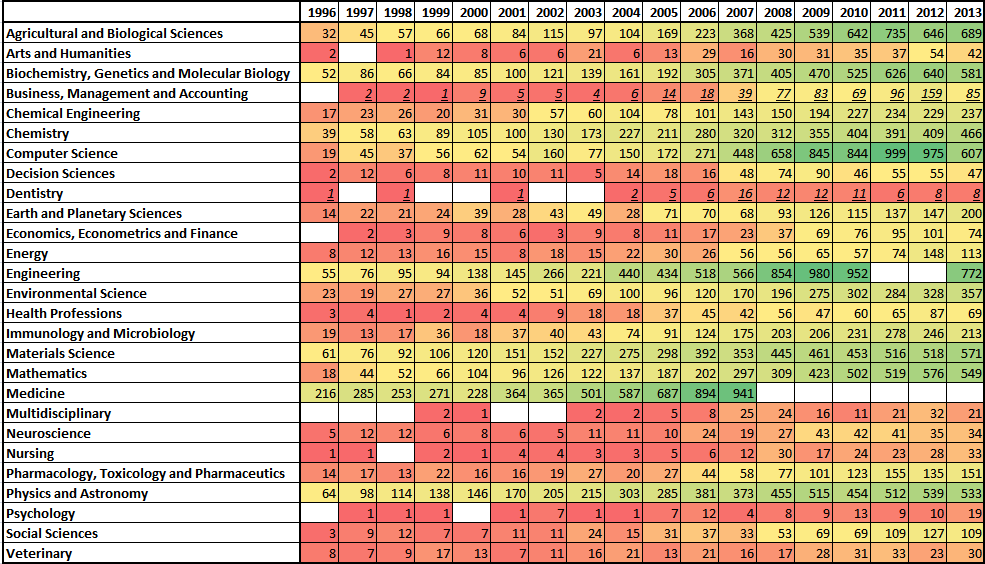In this chart of the week, we shed light on the metrics of scientific publications in Tunisia to understand its dynamics and trace its patterns. Tunisia ranks 59 worldwide with 44798 scientific publications. Many international organizations have developed ranking systems such as the H-index which takes into account publications per capita, citable vs. non-citable effects, etc.
While our goal is not to address the philosophical importance of scientific publications in the country as a whole, it is worth noting that at an individual level, publications provide an effective strategy for visibility and will certainly provide strong competitive advantage in the national and international job market. In fact, many leading companies have found their recruits through scientific publications or in conferences.
The heat map below outlines the number of publications in several fields between 1996 and 2013. The red represents the number of publications lower than the average of the total presentations entered into our data base and green being better-than-average. The first observation is the quasi doubling in publications in the energy sector after 2010 which marked the Tunisian revolution. The same observation could be made about business and management which might signal some interest in entrepreneurship. Tunisians seem to be more active in scientific publications and seem to favor disciplines like mathematics, medicine, engineering, computer science, and agriculture. The three areas where Tunisians are not making the needed effort to publish are veterinary studies, nursing, and dentistry. The lack of veterinary publication should be a concern because many leading pharmaceutical companies try their products on animals before humans and that usually leads to medical breakthroughs. The reason for the low number of publications in the dentistry field remains unclear and could perhaps be the result of classification issues.
Few of the problems that may impede greater publication contribution are the following:
- Access: access to international publications and databases. Very often even leading universities are struggling with databases subscription cost. For instance, Harvard University has recently issued an open letter/warning stating that access to scientific journals costs them approximately $3.5M a year [1].
- Language: while Tunisians are familiar with Roman languages, often an observation is made that many students are still struggling when writing in English. The impact of English on the number of publications is a topic of another research.
- Resources: lack of resources and access to experimental setups. The topic of insufficient public and private R&D spending in Tunisia has been discussed in one of our previous publications [2].
- Motivation: lack of academic and financial incentives
- Mentorship: this is where the problem lies. Anecdotally, many researchers and/or academic supervisors treat their students’ publications as a lower level priority activity and take exaggerated time to assist students with feedback and orientation.
Refrences:
1) http://www.theguardian.com/science/2012/apr/24/harvard-university-journal-publishers-prices
4) http://www.bibliotheque.nat.tn/
data source:
http://scimagojr.com
http://journalmetrics.com

